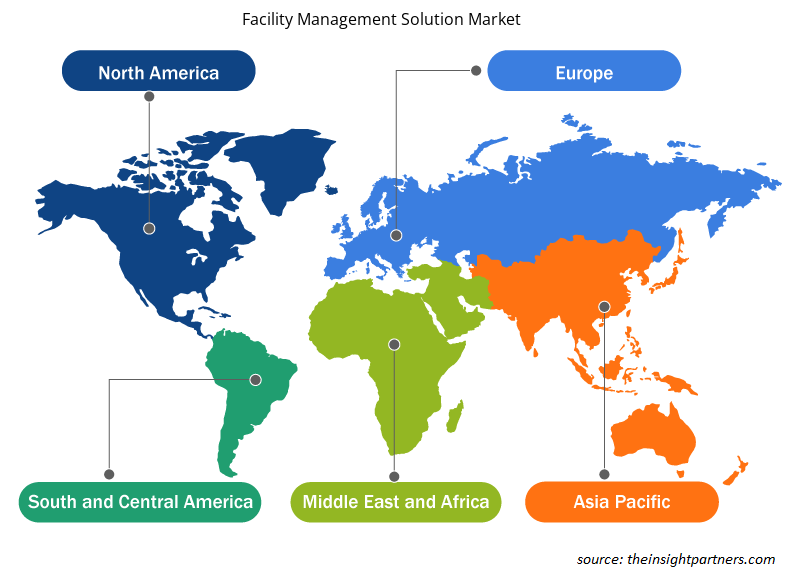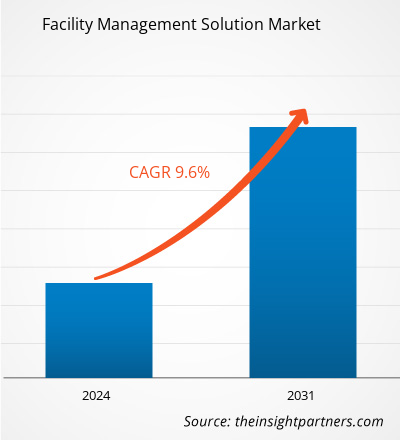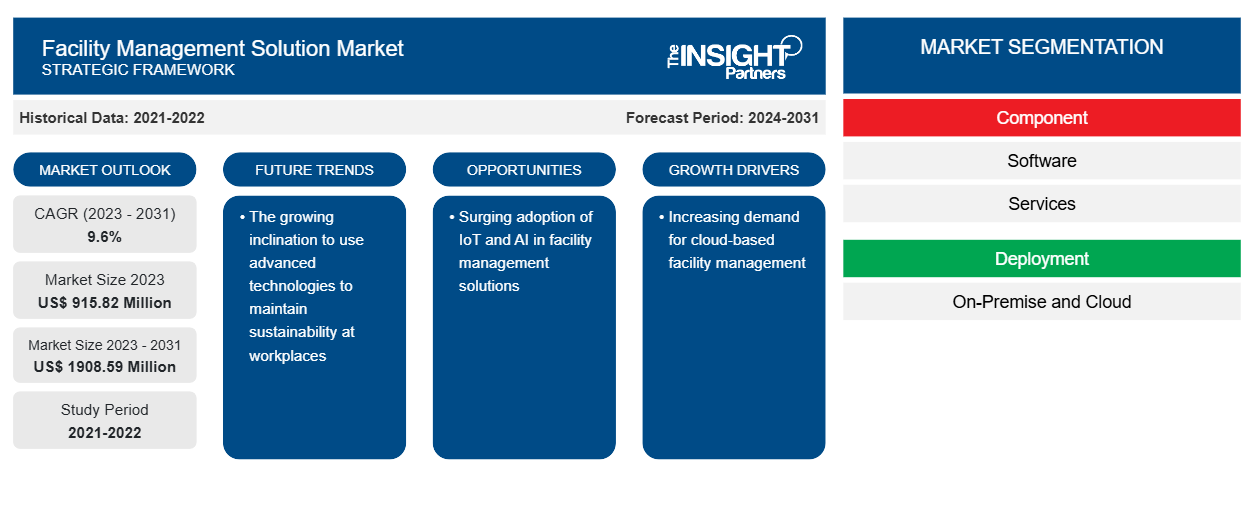Si prevede che la dimensione del mercato delle soluzioni di facility management raggiungerà 1908,59 milioni di dollari entro il 2031, rispetto ai 915,82 milioni di dollari del 2023. Si prevede che il mercato registrerà un CAGR del 9,6% nel periodo 2023-2031. La crescente domanda di soluzioni di facility management basate su cloud e l'adozione in rapida crescita di IoT e AI nelle soluzioni di facility management rimarranno probabilmente tendenze chiave nel mercato.
Analisi di mercato delle soluzioni di facility management
L'adozione di soluzioni di facility management comporta una riduzione dei costi di manodopera ed energia. Pertanto, diverse aziende e organizzazioni in settori quali BFSI, vendita al dettaglio, trasporti e logistica, prodotti farmaceutici, governo, IT e telecomunicazioni, produzione e altri stanno adottando questa soluzione che promuove la sua crescita di mercato a livello globale.
Panoramica del mercato delle soluzioni di facility management
La gestione delle strutture utilizza strumenti e servizi per garantire l'efficacia operativa, la sicurezza e la sostenibilità ambientale di edifici, infrastrutture e immobili. La soluzione si concentra sul supporto di individui e organizzazioni assicurando che l'ambiente costruito, inclusi gli edifici e le infrastrutture circostanti, offra funzionalità, comfort, sicurezza, sostenibilità ed efficienza ottimali. L'obiettivo principale della gestione delle strutture è integrare persone, luoghi e processi all'interno dell'ambiente costruito per migliorare la qualità della vita degli occupanti e migliorare la produttività delle operazioni aziendali principali. Le organizzazioni possono creare un ambiente favorevole che promuove benessere, produttività e successo gestendo efficacemente le strutture.
Personalizza questo report in base alle tue esigenze
Riceverai la personalizzazione gratuita di qualsiasi report, comprese parti di questo report, o analisi a livello nazionale, pacchetto dati Excel, oltre a usufruire di grandi offerte e sconti per start-up e università
-
Scopri le principali tendenze di mercato in questo rapporto.Questo campione GRATUITO includerà analisi di dati che spaziano dalle tendenze di mercato alle stime e alle previsioni.
Driver e opportunità di mercato per le soluzioni di Facility Management
Crescita del settore edile
La crescente urbanizzazione e popolazione sono i principali fattori che guidano le infrastrutture commerciali, residenziali e industriali. I vantaggi della digitalizzazione nel settore delle costruzioni hanno incoraggiato i suoi operatori di mercato ad adottare soluzioni software per gestire in modo efficiente le loro operazioni aziendali e il flusso di lavoro. L'adozione di soluzioni di facility management nel settore delle costruzioni può aiutare gli operatori di mercato a mantenere e gestire in modo efficiente la nuova infrastruttura. Anche le funzionalità del software come la manutenzione preventiva, la gestione degli spazi e altre possono aiutare a costruire in modo efficiente la nuova infrastruttura. Pertanto, il crescente settore delle costruzioni può creare opportunità redditizie per il mercato delle soluzioni di facility management.digitalization in the construction industry have encouraged its market players to adopt software solutions to efficiently manage their business operations and workflow. The adoption of facility management solutions in the construction industry can help the market players maintain and manage the new infrastructure efficiently. The features of software such as preventive maintenance, space management, and others can also help to build the new infrastructure efficiently. Thus, the growing construction industry can create lucrative opportunities for the facility management solution market.
Domanda di soluzioni basate sul cloud.
La scalabilità e la flessibilità offerte dalle soluzioni cloud stanno portando all'adozione del mercato delle soluzioni di facility management basate su cloud. La soluzione conveniente basata su cloud aiuta le organizzazioni a gestire le proprie strutture e risorse. Offre funzionalità di gestione dei dati migliorate centralizzando l'archiviazione e la gestione nel cloud. Vari attori del mercato stanno fornendo soluzioni di facility management basate su cloud per soddisfare la domanda di soluzioni basate su cloud. Ad esempio, QuickFMS fornisce software di facility management basato su cloud che consente all'organizzazione di gestire e tracciare le richieste di manutenzione, pianificare la manutenzione preventiva, gestire l'inventario , tracciare le risorse, monitorare il consumo di energia e altro ancora.QuickFMS provides cloud-based facility management software that enables the organization to manage and track maintenance requests, schedule preventive maintenance, manage
Analisi della segmentazione del rapporto di mercato delle soluzioni di Facility Management
I segmenti chiave che hanno contribuito alla derivazione dell'analisi di mercato delle soluzioni di facility management sono i componenti, l'implementazione, le dimensioni aziendali e l'applicazione.
- In base al componente, il mercato delle soluzioni di facility management è segmentato in software e servizi. Il segmento software ha detenuto la quota maggiore del mercato nel 2023.
- Per distribuzione, il mercato è segmentato in on-premise e cloud. Si prevede che il segmento cloud crescerà con il CAGR più elevato.CAGR.
- In base alle dimensioni aziendali, il mercato delle soluzioni di facility management è segmentato in grandi aziende e PMI. Si prevede che il segmento delle grandi aziende crescerà con il CAGR più elevato.SMEs. The large enterprises segment is expected to grow with the highest CAGR.
- Per applicazione, il mercato è segmentato in BFSI, vendita al dettaglio, trasporti e logistica, prodotti farmaceutici, governo, IT e telecomunicazioni, produzione e altri. Il segmento IT e telecomunicazioni ha detenuto una quota significativa del mercato nel 2023.BFSI, retail, transport and logistics, pharmaceuticals, government, IT and telecom, manufacturing, and others. The IT and telecom segment held a significant share of the market in 2023.
Analisi della quota di mercato delle soluzioni di Facility Management per area geografica
L'ambito geografico del rapporto di mercato sulle soluzioni di facility management è suddiviso principalmente in cinque regioni: Nord America, Asia Pacifico, Europa, Medio Oriente e Africa, Sud e Centro America.
La regione Asia-Pacifico detiene la quota di mercato più grande e si prevede che crescerà con il CAGR più elevato. La crescente digitalizzazione e l'aumento dell'adozione di soluzioni software stanno guidando la crescita del mercato. La crescente digitalizzazione tra le PMI e la necessità di una gestione efficiente delle strutture sono alcuni dei principali fattori trainanti del mercato delle soluzioni di gestione delle strutture.CAGR. The growing digitalization and rise in the adoption of software solutions are driving market growth. The growing digitalization among SMEs and the need for efficient facility management are some of the major driving factors of the facility management solution market.
Approfondimenti regionali sul mercato delle soluzioni di facility management
Le tendenze regionali e i fattori che influenzano il Facility Management Solution Market durante il periodo di previsione sono stati ampiamente spiegati dagli analisti di Insight Partners. Questa sezione discute anche i segmenti e la geografia del Facility Management Solution Market in Nord America, Europa, Asia Pacifico, Medio Oriente e Africa e Sud e Centro America.

- Ottieni i dati specifici regionali per il mercato delle soluzioni di facility management
Ambito del rapporto di mercato sulle soluzioni di facility management
| Attributo del report | Dettagli |
|---|---|
| Dimensioni del mercato nel 2023 | 915,82 milioni di dollari USA |
| Dimensioni del mercato entro il 2031 | 1908,59 milioni di dollari USA |
| CAGR globale (2023-2031) | 9,6% |
| Dati storici | 2021-2022 |
| Periodo di previsione | 2024-2031 |
| Segmenti coperti |
Per componente
|
| Regioni e Paesi coperti |
America del Nord
|
| Leader di mercato e profili aziendali chiave |
|
Densità degli attori del mercato delle soluzioni di Facility Management: comprendere il suo impatto sulle dinamiche aziendali
Il mercato delle soluzioni di Facility Management sta crescendo rapidamente, spinto dalla crescente domanda degli utenti finali dovuta a fattori quali l'evoluzione delle preferenze dei consumatori, i progressi tecnologici e una maggiore consapevolezza dei vantaggi del prodotto. Con l'aumento della domanda, le aziende stanno ampliando le loro offerte, innovando per soddisfare le esigenze dei consumatori e capitalizzando sulle tendenze emergenti, il che alimenta ulteriormente la crescita del mercato.
La densità degli operatori di mercato si riferisce alla distribuzione di aziende o società che operano in un particolare mercato o settore. Indica quanti concorrenti (operatori di mercato) sono presenti in un dato spazio di mercato in relazione alle sue dimensioni o al valore di mercato totale.
Le principali aziende che operano nel mercato delle soluzioni di Facility Management sono:
- Axonator Inc
- Facilitron, Inc
- FacilityBot Pte Ltd
- FM:Sistemi
- Vixxo
- Società IBM
Disclaimer : le aziende elencate sopra non sono classificate secondo un ordine particolare.

- Ottieni la panoramica dei principali attori del mercato delle soluzioni di Facility Management
Notizie di mercato e sviluppi recenti sulle soluzioni di Facility Management
Il mercato delle soluzioni di facility management viene valutato raccogliendo dati qualitativi e quantitativi dopo la ricerca primaria e secondaria, che include importanti pubblicazioni aziendali, dati associativi e database. Di seguito sono elencati alcuni degli sviluppi nel mercato delle soluzioni di facility management:
- Facility Vitals, un importante fornitore di soluzioni di facility management, ha annunciato il rilascio della sua innovativa soluzione software, che promette di rivoluzionare il modo in cui i facility manager gestiscono le proprie operazioni. Il nuovo software dell'azienda è stato progettato per semplificare la gestione delle strutture, fornendo ai facility manager gli strumenti di cui hanno bisogno per gestire le proprie strutture in modo più efficiente ed efficace. (Fonte: Newsfile Corp, comunicato stampa, marzo 2023)
Copertura e risultati del rapporto di mercato sulle soluzioni di facility management
Il rapporto "Dimensioni e previsioni del mercato delle soluzioni di facility management (2021-2031)" fornisce un'analisi dettagliata del mercato che copre le seguenti aree:
- Dimensioni e previsioni del mercato delle soluzioni di facility management a livello globale, regionale e nazionale per tutti i principali segmenti di mercato coperti dall'ambito
- Tendenze del mercato delle soluzioni di facility management, nonché dinamiche di mercato quali driver, vincoli e opportunità chiave
- Analisi dettagliata delle cinque forze PEST/Porter e SWOT
- Analisi di mercato delle soluzioni di facility management che copre le principali tendenze di mercato, il quadro globale e regionale, i principali attori, le normative e i recenti sviluppi del mercato
- Analisi del panorama industriale e della concorrenza che copre la concentrazione del mercato, l'analisi della mappa di calore, i principali attori e gli sviluppi recenti per il mercato delle soluzioni di facility management
- Profili aziendali dettagliati
- Analisi storica (2 anni), anno base, previsione (7 anni) con CAGR
- Analisi PEST e SWOT
- Valore/volume delle dimensioni del mercato - Globale, Regionale, Nazionale
- Industria e panorama competitivo
- Set di dati Excel
Report recenti
Rapporti correlati
Testimonianze
Motivo dell'acquisto
- Processo decisionale informato
- Comprensione delle dinamiche di mercato
- Analisi competitiva
- Analisi dei clienti
- Previsioni di mercato
- Mitigazione del rischio
- Pianificazione strategica
- Giustificazione degli investimenti
- Identificazione dei mercati emergenti
- Miglioramento delle strategie di marketing
- Aumento dell'efficienza operativa
- Allineamento alle tendenze normative























 Ottieni un campione gratuito per - Mercato delle soluzioni di gestione delle strutture
Ottieni un campione gratuito per - Mercato delle soluzioni di gestione delle strutture